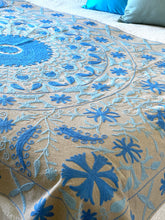
Beautiful handcrafted Suzani Throw is just perfect for throwing on the end of a bed, hanging on the wall or using to create a headboard or covering a chair or ottoman. Each piece is hand crafted and as such is unique and imbued with some charming, inherent imperfections. The piece is 'raw' with the embroidery threads exposed on the back but is easily 'backed' if required. Small inconsistencies are an inherent part of the charm of this handcrafted textile.
Weave: Needlework Hand embroidered with 100% silk thread on 100% cotton fabric
Size: CM X CM
Care: Dry Clean.
Suzani make delightful wall hangings, bedspreads, throws, pillows, or even tablecloths.
What is Suzani?
Size: CM X CM
Care: Dry Clean.
Suzani make delightful wall hangings, bedspreads, throws, pillows, or even tablecloths.
What is Suzani?
Suzani are expertly crafted by skilled artists and their size and density of stitches are awe-inspiring. The stitching is what gives these textiles their name. These large textile panels were made by nomadic tribes and were an integral part of their nomadic lifestyle. Most suzanis are made of cotton, although sometimes a maker opted for silk. The intricate pattern is drawn onto the cotton base fabric before embroidering begins. While traditional suzanis were stitched with naturally dyed threads eventually, synthetically dyed threads came into use.
Suzani embroidery is a unique traditional craft and art (a hand-embroidered, decorative textile) practiced by women living in Central Asia. The term is derived from the Persian word for needlework, "suzanikari".

















